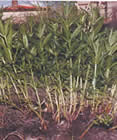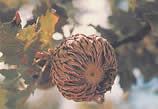Your wish list is empty.
Oriental Rugs » Anatolian Dye Plants
Dye Plants In Western Anitolia (Turkey)
by Dr. Harald Bohmer

Indigo,
Indigofera
Tinctora
Producing Blue
Among natural dyes for blue, Indigo has no serious competitors. Beautiful and lightfast - even under desert sun - Indigo has been used for four thousand years.

Shoots of madder,
Rubia Tinctorum
Producing Red
There is only one dye plant available for red: madder (Rubia titictornm). In many places, and in the regions where it was previously cultivated, madder grows wild — particularly in cotton fields, where it is a weed. Experiments with the cultivation of madder have been undertaken on state-owned plantations in the Dardanelles area, but cultivation on a larger scale is not necessary yet, because there are now tons of madder roots on the market.
Producing Yellow

Dyer's weed or
Weld, Reseda
Luteola L.

Chamomile,
Anthemis Chia L.
There are many-plants containing yellow dyestuffs. According to my studies, the following plants formerly were used and have now been reintroduced: stinking chamomile (Anthemis chia, etc.) dyer's chamomile (Antitemis tinctoria) weld (Reseda luteola) German chamomile (Matricaria clulinomilla) spurge (Euphorbia biglandulosa, etc.) three-leafed sage (Salvia triloba) St.-John's-wort (Hyperwnm empetrifoliain) false hemp (Datisca caimabina) dyer's sumach (Rims coriarul) The lightfastness of yellow dyes varies widely. Chamomile and weld, depending on the mordant, yield the most stable yellow. The biennial weld — which is a favourite food of goats, sheep, donkeys, and cattle — grows wild in several areas of Anatolia. We took seeds to the villages, and now weld grows in many gardens. Analysis often proved the existence in old western Anatolian carpets of a combination of dyestuffs which at first could not be attributed to a particular plant. As a result of further investigations, we can now say that the dye probably was produced from Initia viscosa, which blossoms in September and October, when almost all the other dye plants for yellow have already withered. Provided certain dyeing conditions are observed, it yields a fine, lightfast yellow.

Walloon Oak,
Quercus Ithaburensis
Producing Black
Black results from a mixture of plant extracts containing tannin and ferrous chemical compounds. The black colour used in carpets is made from gallnuts, acorn shells, and the leaves of dyer's sumach. As is seen in old carpets, this black colour causes the wool to deteriorate. The black produced from dyer's sumach seems to be the longest-lived.
Producing Green
There is no dye plant that will yield a fast and intense green. The green in old carpets is always the product of a mixture of blue (indigo) and yellow dyestuffs. The same principle is applied to produce the green colour for DOBAG carpets. We will not reintroduce indigo sulfonic acid for blue — used extensively in Anatolia in the last century — because it often yields dull green tones and runs readily.
Producing Orange
As a rule, orange is obtained from a mixture of red (madder) and yellow (various plants).
Producing Violet
In 1982, following up on a suggestion by ethnographer Josephine Powell of Istanbul, we were able to rediscover the old method of producing violet from madder alone (without indigo). This technique is being kept as a DOBAG trade secret.


